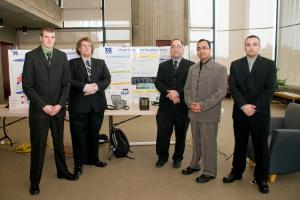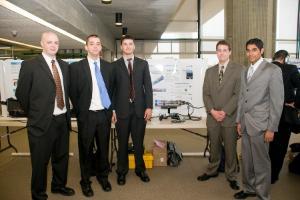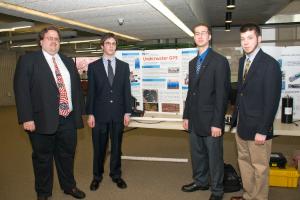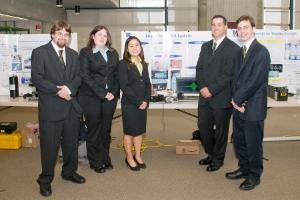2008
Senior Design AY 2007-2008
Senior Design Instructor:
Dr. Howard Michel
ECE 457/458 Design Project I/II is the capstone design experience where students expand their abilities and develop important real world engineering problem solving skills. The students were divided into four groups. The details are given below.
| Project Title | |
|---|---|
| Group 1 | Power Savings for Standby Devices |
| Group 2 | Wireless/Acoustic Marine System (SWAMS) |
| Group 3 | Underwater Global Positioning System |
| Group 4 | Bike Safe Sound System |
Group 1
Student Members:
Matthew Avery
Antonio Couto
Jason Fisher
Ankit Madan
Philip Meyer
Faculty Advisor:
Professor Robert Helgeland
Project Title:
Power Savings for Standby Devices
Project Description:
Several electron devices in the home and office waste power. TV's, computers, video recorders, batter chargers, and even coffee pots can include electronics which consume power when switched off or left alone in a standby state. Turning off these electronics when in standby states can save consumers money from less power consumption and help reduce stresses on current power grids. Our project is to design a system to eliminate standby power consumption of home and office electronics. Our customer, the Advanced Technology and Manufacturing Center, requested an automated control system to save power consumption in devices in standby mode. The chosen deign consists of power sensor/interceptor system connected through power line modems (PLM) to a controller. The controller supports a website through an Ethernet connection to provide an interface to the user through a computer's internet browser.
Group 2
Student Members:
Kyle Blanchard
Jamie Donais
Bryan Leary
Michael Morin
Saikaran Reddy
Faculty Advisor:
Dr. Dayalan Kasilingam
Project Title:
Wireless/Acoustic Marine System (SWAMS)
Project Description:
Project customer SubChem Systems offers specialized submersible chemical analyzers for nutrients, trace metals and other chemicals. One of SubChem's newest analyzers, Chemfin, is designed to be eternally attached to an AUV or underwater sensor platform. To retrieve chemical data after deployment, SubChem engineers must physically connect to the Chemfin console. SubChem requires a stand-alone wireless communications system that ill allow for remote access to Chemfin. Utilizing acoustic and Wi-Fi technology, the SubChem Wireless/Acoustic Marine system(SWAMS) is an easy-to-integrate, stand alone wireless data link to any chemical analyzer. The system allows for access to real time chemical data as well as control of chemical analysis settings. The SWAMS module will also be equipped with a GPS receiver for easy tracking. All chemical/GPS data will be sent to an "on-shore" user to be displayed on the custom Lab VIEW SWAMS desktop software
Group 3
Student Members:
Jeffrey Chalas
Stephen Harnois
Julian Plante
Nicholas Savery
Faculty Advisor:
Dr. Gilbert Fain
Project Title:
Underwater Global Positioning System
Project Description:
Ocean server Technology has built a low cost AUV(autonomous underwater vehicle) called the Iver2. This vehicle is used mainly for data collection and surveys in a coastal marine environment, and was designed with the primary intent of being easily modified and deployed at a low cost. The Iver2 is priced in the $50,000 dollar range, and is far less expensive then the nearest competitor, making it a leader in its specialized niche. The Iver2 currently uses a method known as Dead Reckoning in order to determine its position underwater. Dead Reckoning estimates a position using the known desired heading and the desired velocity. This can be quite inaccurate because it does not account for the vehicle's real heading or velocity, making the vehicle highly susceptible to errors caused by underwater currents. Dead Reckoning will also loose accuracy as the time since the last GPS fix increases. The second solution Ocean-Server employs is a towed GPS device. This device floats on the surface and relays current GPS information down to a AUV. This solution also has major flaws stemming from the tether itself. Towing also induces added drag, inhibiting vehicle performance. The existing solution to get the better accuracy is an Inertial Navigational System, Doppler Velocity Log( INS DVL). These systems use precise sensors to track the actual displacement with respect to the vehicle's environment, creating a much more accurate estimate of the AUV'S position underwater. These systems are still susceptible to accuracy loss with time. The INS DVL is also extremely expensive, on the order of 300% or more of the cost of the Iver2 itself. While this is reasonable price when the system will be deployed on a manned submarine or a high cost AUV; this is very impractical for a vehicle of low cost. The objective of this project is to design and implement an underwater position monitoring system that will provide similar accuracy to the DVL, but at a much more reasonable cost. The system will attempt to translate the GPS concept to the underwater domain in order to solve this problem.
Group 4
Student Members:
Boris Berdichevsky
Yvonne Chan
Mark Francis
Kelly Ouellette
Benjamin Viall
Faculty Advisor:
Dr. Karen Payton
Project Title:
Bike Safe Sound System
Project Description:
This final report is a documentation of our senior design project. For two semesters, our team worked to design, build, test, and document a system that would allow a bicyclist to safely ride a bike while listening to audio from an MP3 player. In the Fall semester, we worked at designing a hardware systems. Midway through the second semester, it was apparent that we were much closer to our first semester goal than we had anticipated. The final product presented in our final presentation is a system satisfying a combination of first and second requirements.




